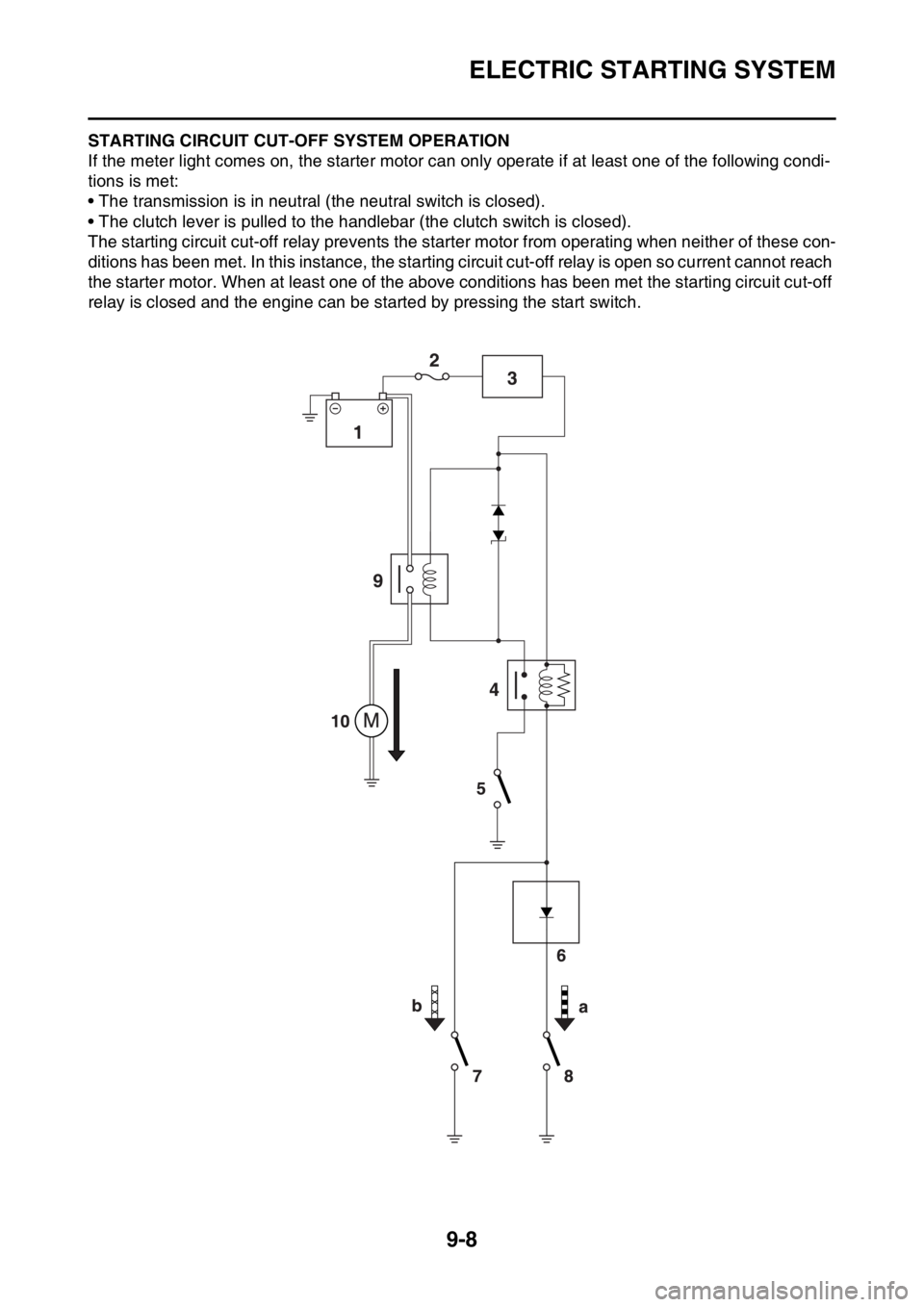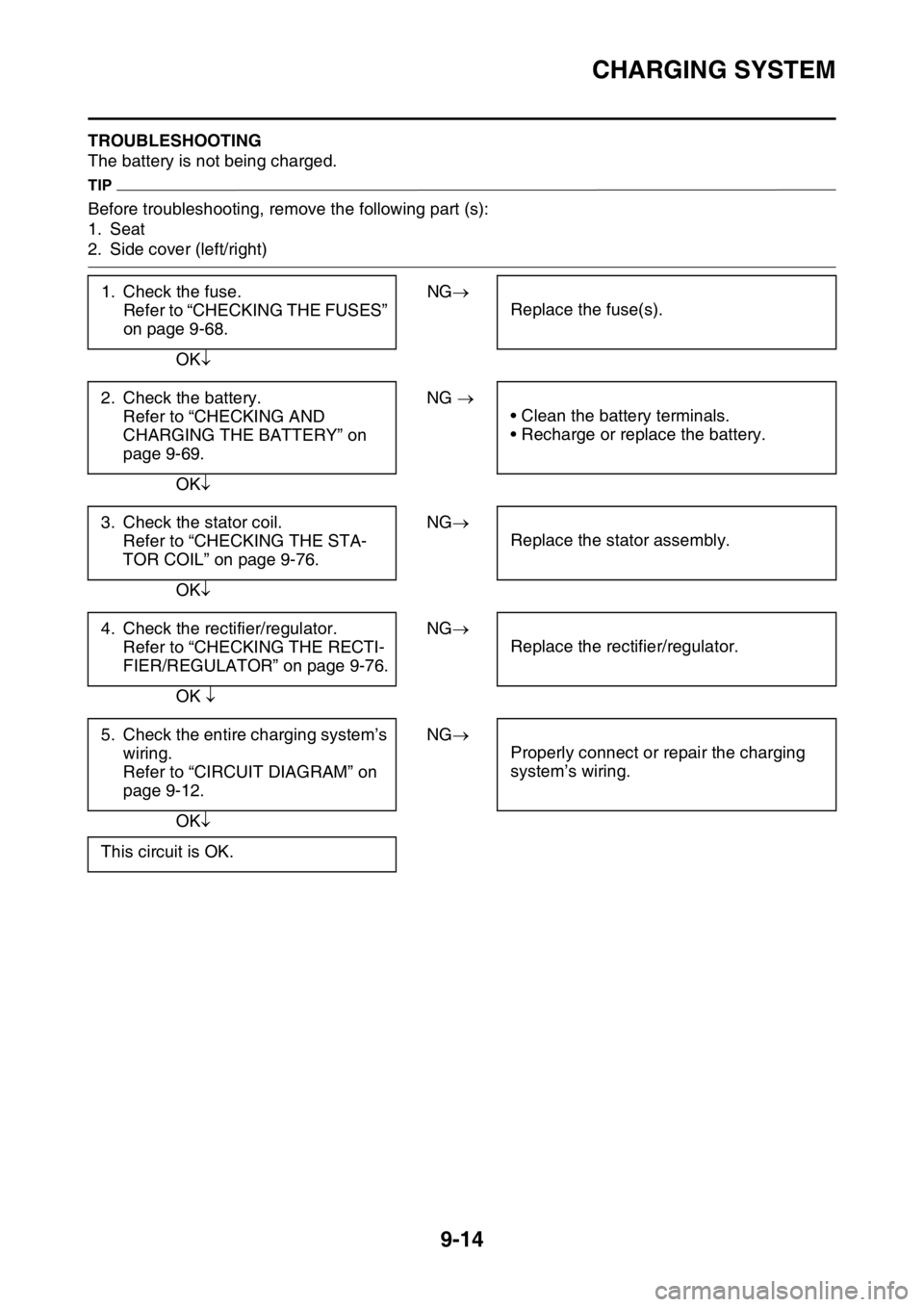YAMAHA WR 250F 2017 Owners Manual
WR 250F 2017
YAMAHA
YAMAHA
https://www.carmanualsonline.info/img/51/52286/w960_52286-0.png
YAMAHA WR 250F 2017 Owners Manual
Trending: tow, seats, coolant, change time, wheel alignment, water pump, transmission fluid
Page 341 of 432
IGNITION SYSTEM
9-5
8. Check the lean angle sensor.
Refer to “CHECKING THE LEAN
ANGLE SENSOR” on page 9-75.NG
Replace the lean angle sensor.
OK
9. Check the entire ignition system’s
wiring.
Refer to “CIRCUIT DIAGRAM” on
page 9-2.NG
Properly connect or repair the ignition sys-
tem’s wiring.
OK
Replace the ECU.
Page 342 of 432
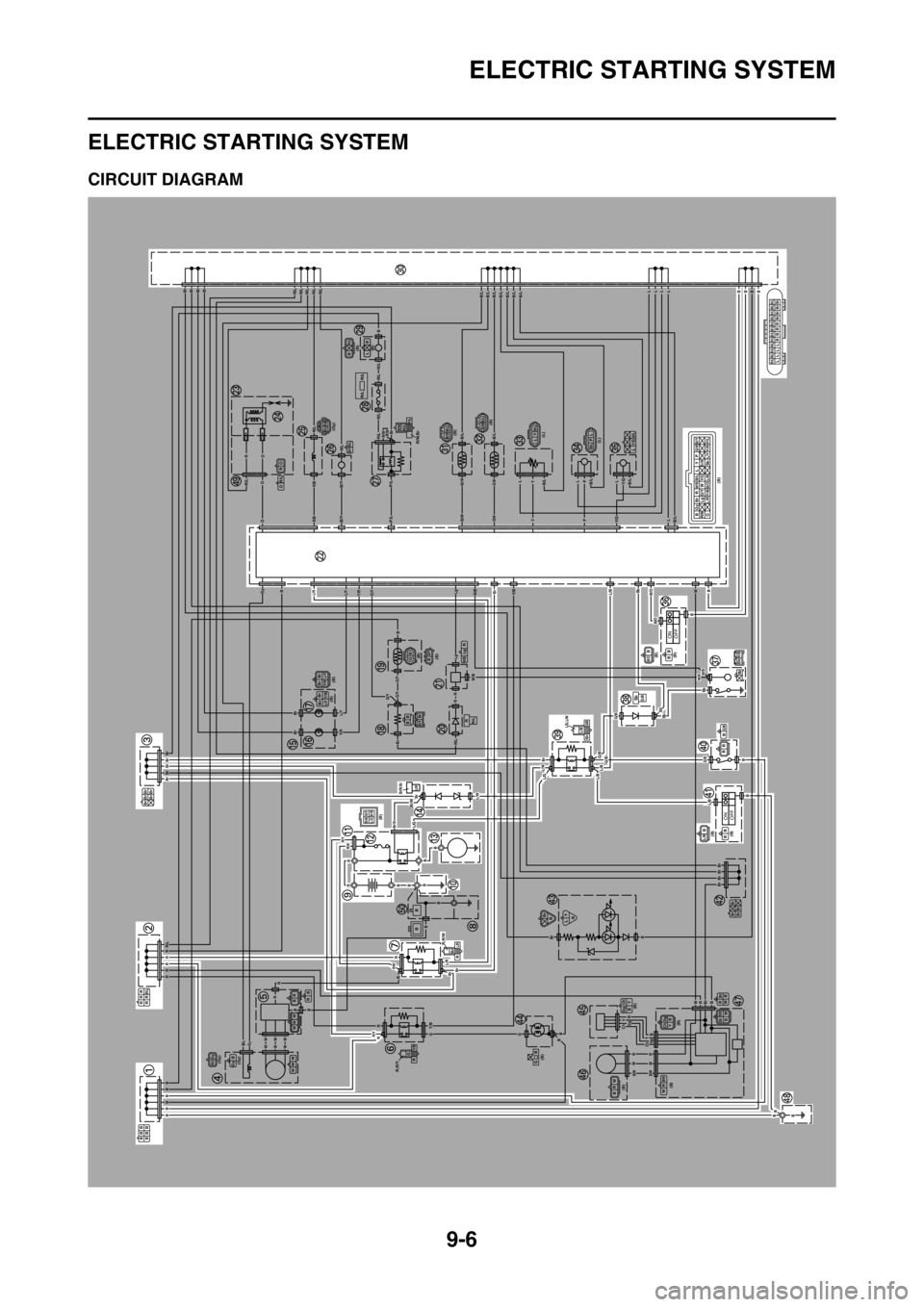
ELECTRIC STARTING SYSTEM
9-6
EAS27160
ELECTRIC STARTING SYSTEM
EAS2GBB360CIRCUIT DIAGRAM
ONOFF
ONOFF
BBB
BBB
RRR
RRR/L
Br Br Br
Br Br
(Gy)
(Gy)B/LGyWW WB Gy
B R
WW W
BR
R,R/Y
G
R
Y/B
R,R/W
Br
RL/R
(B)R/YR/WBr/WL/G
Br/W,BrL/W
(B) (B)Br BrL/Y Y/R
G/YBrBB
BrBrL/YY/W
(B)(B)BB GG/Y
RR/L
R Lg
W/B
(B) BGyBr RW/BB/LLYP
G/WB/Y
R/BLgG/YW
Br/W
OL/RY/BB/OL/BSbY/R L/Y P/L
Y/G
(Gy)R/L R/BR/LB/Y
R/WR/L
R/W,BrP/L
R/L R/L
(B)
(B)
(B)
(L)
(L)(B) BR/LLBR/L R/L R/L R/L R/L B/L B/L B/L B/L B/L B/L B/LL L L LBBBB
Br Br Br Br
B/LBr/W
B/LG/WLYB/L
B/LPLB/LY/GL
(B)
(B)B/OBB BSbW/B
Sb
SbG/B
L/G,L/WL/BBrG/BG/BB
BB
(B)
(B)L/BBB B
Br Br
Br BrBr
BB LY
(B)
(B)
(B)
(B)
(B)
GB
Ch Dg
Y B
BRW
Br R
B W
B/WR W
Ch DgYBBrR/WBW
R O
OR/L
B
B
BBBBBB
RRRRRR/L
BrBrBrBrBr
Br
Br
BrBrBrBrR/LR/LR/LR/LR/L
B
LLLP
PL
Y
Y
RR
Br
R/LR/L
R/L
P/L
P/L
R/L
R/L
R/LR/B
R/B
L/RL/Y
L/Y
Y/R
Y/R
G/Y
G/YG/Y
G/Y
B/Y
B/Y
R/LB/LB/L
B/LB/LB/LY/G
Y/GB/L
B/OL/BY/BW/B
W/B
G/B
L/B
W/BW/B
L/BL/BL/GL/W
L/W
L/R
Br/W
Br/W
R/W
R/W
R/Y
R/Y
G/BG/B
G/B
B/O
B/LB/LB/LB/LB/LB/LB/L
G/W
G/W
Br/W
Br/W
R/WR/WBr
O
O
OR
RGy
LLLLBBBB
B
B
B
B
BBB
B
B
RRWW
Y
Y
Dg
Dg
Ch
Ch
RW
BrBrBrBr
Br
B
W
Sb
SbSb
SbBr
Br
B
Br
Lg
Lg
R/L
R
R
RR
Gy
BB
WWWWWW
R
RRGGBB
B
Y/B
RB
BB
B
B
Br
Br
Br
B
L/G
B/L
B/WB/W
B
Page 343 of 432
ELECTRIC STARTING SYSTEM
9-7
1. Joint connector
2. Joint connector
3. Joint connector
7. Main relay
9. Battery
10.Frame ground
11.Starter relay
12.Main fuse
13.Starter motor
14.Starter relay diode
22.ECU (engine control unit)
30.Joint connector
36.Engine stop switch
37.Neutral switch
38.Diode
39.Starting circuit cut-off relay
40.Clutch switch
41.Start switch
48.Frame ground
Page 344 of 432
ELECTRIC STARTING SYSTEM
9-8
EAS2GBB361STARTING CIRCUIT CUT-OFF SYSTEM OPERATION
If the meter light comes on, the starter motor can only operate if at least one of the following condi-
tions is met:
• The transmission is in neutral (the neutral switch is closed).
• The clutch lever is pulled to the handlebar (the clutch switch is closed).
The starting circuit cut-off relay prevents the starter motor from operating when neither of these con-
ditions has been met. In this instance, the starting circuit cut-off relay is open so current cannot reach
the starter motor. When at least one of the above conditions has been met the starting circuit cut-off
relay is closed and the engine can be started by pressing the start switch.
Page 345 of 432
ELECTRIC STARTING SYSTEM
9-9
a. WHEN THE TRANSMISSION IS IN NEU-
TRAL
b. WHEN THE CLUTCH LEVER IS PULLED
TO THE HANDLEBAR
1. Battery
2. Main fuse
3. Main relay
4. Starting circuit cut-off relay
5. Start switch
6. Diode
7. Clutch switch
8. Neutral switch
9. Starter relay
10.Starter motor
Page 346 of 432
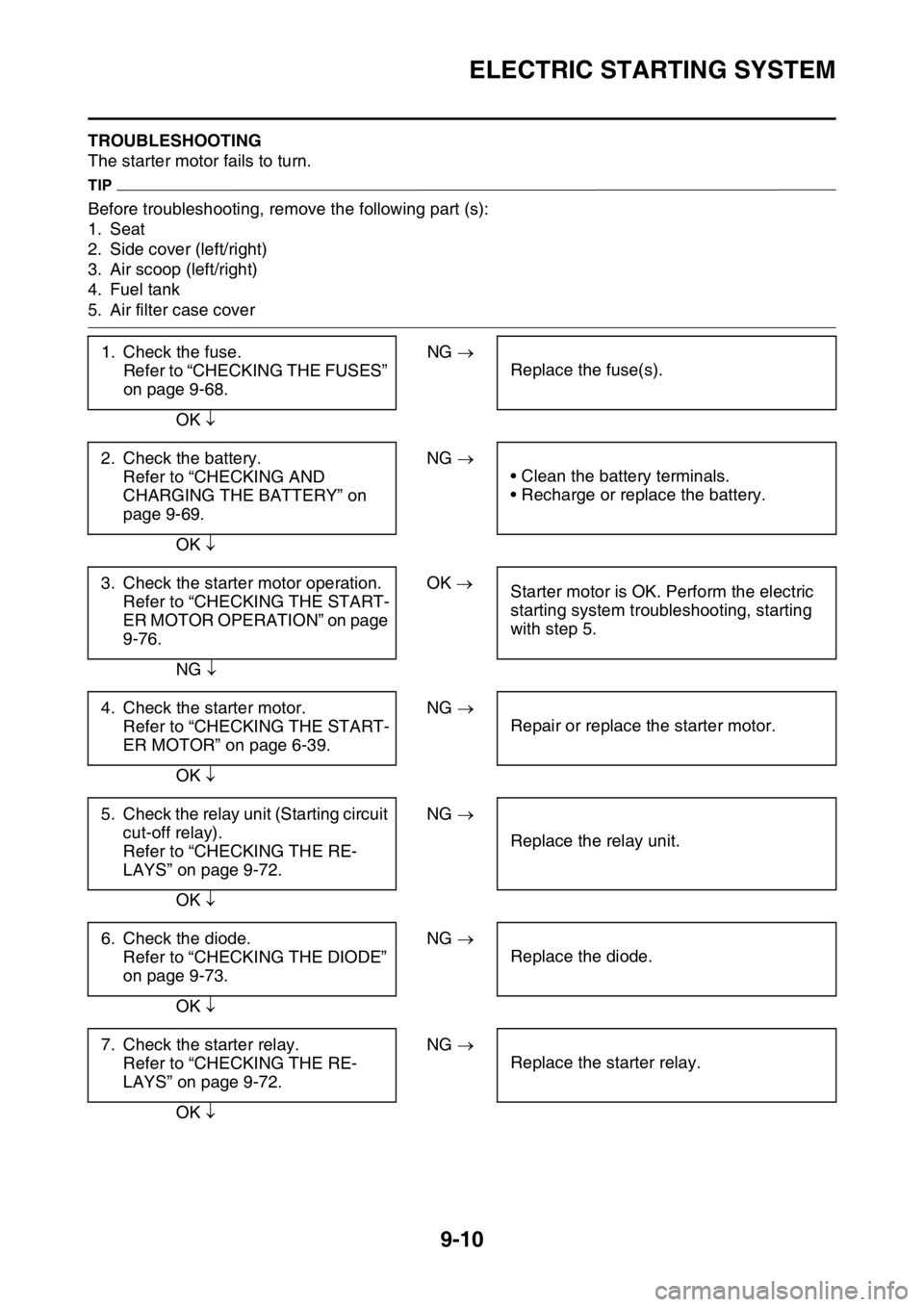
ELECTRIC STARTING SYSTEM
9-10
EAS2GBB362TROUBLESHOOTING
The starter motor fails to turn.
TIP
Before troubleshooting, remove the following part (s):
1. Seat
2. Side cover (left/right)
3. Air scoop (left/right)
4. Fuel tank
5. Air filter case cover
1. Check the fuse.
Refer to “CHECKING THE FUSES”
on page 9-68.NG
Replace the fuse(s).
OK
2. Check the battery.
Refer to “CHECKING AND
CHARGING THE BATTERY” on
page 9-69.NG
• Clean the battery terminals.
• Recharge or replace the battery.
OK
3. Check the starter motor operation.
Refer to “CHECKING THE START-
ER MOTOR OPERATION” on page
9-76.OK
Starter motor is OK. Perform the electric
starting system troubleshooting, starting
with step 5.
NG
4. Check the starter motor.
Refer to “CHECKING THE START-
ER MOTOR” on page 6-39.NG
Repair or replace the starter motor.
OK
5. Check the relay unit (Starting circuit
cut-off relay).
Refer to “CHECKING THE RE-
LAYS” on page 9-72.NG
Replace the relay unit.
OK
6. Check the diode.
Refer to “CHECKING THE DIODE”
on page 9-73.NG
Replace the diode.
OK
7. Check the starter relay.
Refer to “CHECKING THE RE-
LAYS” on page 9-72.NG
Replace the starter relay.
OK
Page 347 of 432
ELECTRIC STARTING SYSTEM
9-11
8. Check the main relay.
Refer to “CHECKING THE RE-
LAYS” on page 9-72.NG
Replace the main relay.
OK
9. Check the neutral switch.
Refer to “CHECKING THE
SWITCHES” on page 9-64.NG
Replace the neutral switch.
OK
10.Check the clutch switch.
Refer to “CHECKING THE
SWITCHES” on page 9-64.NG
Replace the clutch switch.
OK
11.Check the engine stop switch.
Refer to “CHECKING THE
SWITCHES” on page 9-64.NG
Replace the engine stop switch.
OK
12.Check the start switch.
Refer to “CHECKING THE
SWITCHES” on page 9-64.NG
Replace the start switch.
OK
13.Check the entire starting system’s
wiring.
Refer to “CIRCUIT DIAGRAM” on
page 9-6.NG
Properly connect or repair the starting sys-
tem’s wiring.
OK
Replace the ECU.
Page 348 of 432
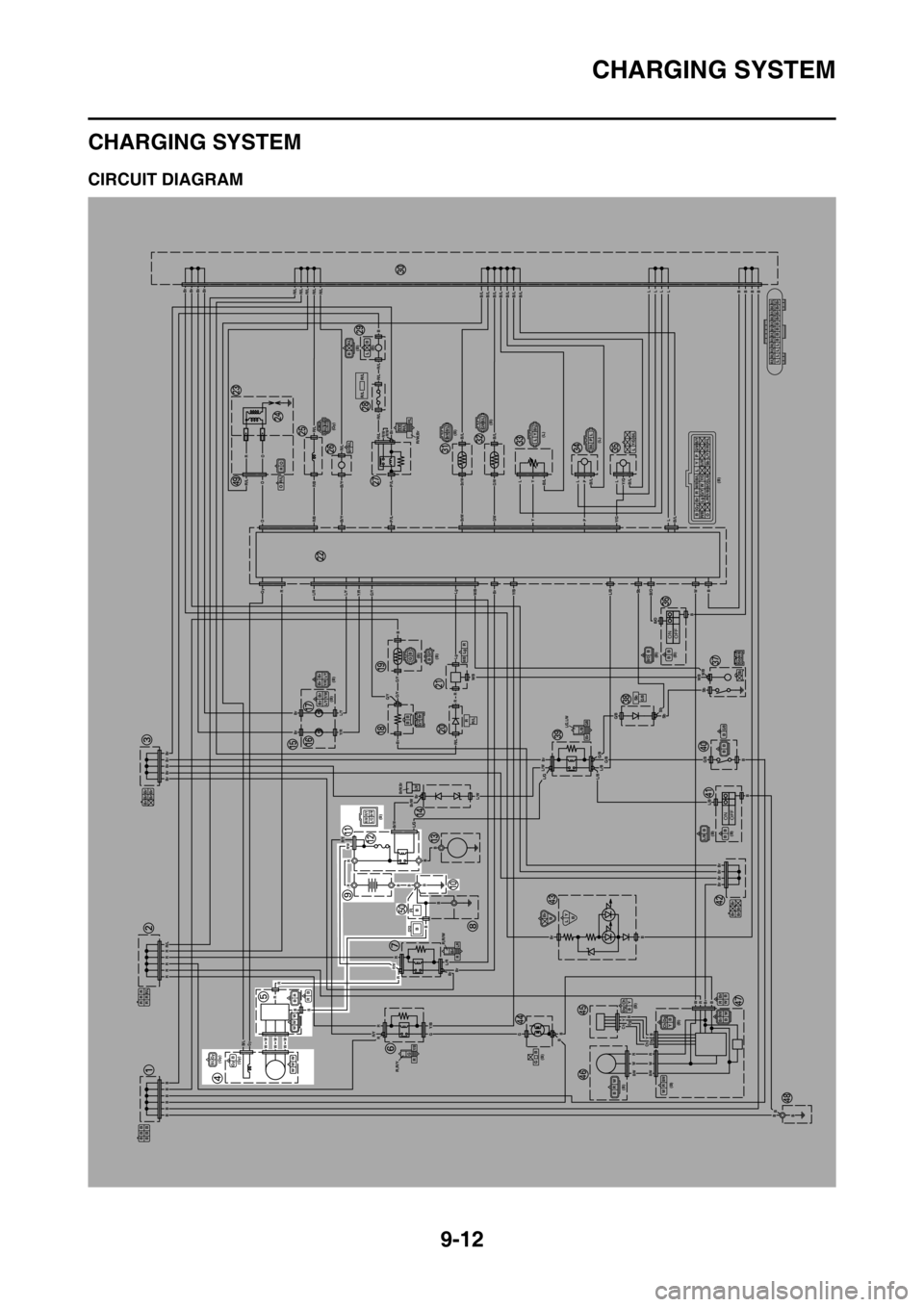
CHARGING SYSTEM
9-12
EAS27200
CHARGING SYSTEM
EAS2GBB363CIRCUIT DIAGRAM
ONOFF
ONOFF
BBB
BBB
RRR
RRR/L
Br Br Br
Br Br
(Gy)
(Gy)B/LGyWW WB Gy
B R
WW W
BR
R,R/Y
G
R
Y/B
R,R/W
Br
RL/R
(B)R/YR/WBr/WL/G
Br/W,BrL/W
(B) (B)Br BrL/Y Y/R
G/YBrBB
BrBrL/YY/W
(B)(B)BB GG/Y
RR/L
R Lg
W/B
(B) BGyBr RW/BB/LLYP
G/WB/Y
R/BLgG/YW
Br/W
OL/RY/BB/OL/BSbY/R L/Y P/L
Y/G
(Gy)R/L R/BR/LB/Y
R/WR/L
R/W,BrP/L
R/L R/L
(B)
(B)
(B)
(L)
(L)(B) BR/LLBR/L R/L R/L R/L R/L B/L B/L B/L B/L B/L B/L B/LL L L LBBBB
Br Br Br Br
B/LBr/W
B/LG/WLYB/L
B/LPLB/LY/GL
(B)
(B)B/OBB BSbW/B
Sb
SbG/B
L/G,L/WL/BBrG/BG/BB
BB
(B)
(B)L/BBB B
Br Br
Br BrBr
BB LY
(B)
(B)
(B)
(B)
(B)
GB
Ch Dg
Y B
BRW
Br R
B W
B/WR W
Ch DgYBBrR/WBW
R O
OR/L
B
B
BBBBBB
RRRRRR/L
BrBrBrBrBr
Br
Br
BrBrBrBrR/LR/LR/LR/LR/L
B
LLLP
PL
Y
Y
RR
Br
R/LR/L
R/L
P/L
P/L
R/L
R/L
R/LR/B
R/B
L/RL/Y
L/Y
Y/R
Y/R
G/Y
G/YG/Y
G/Y
B/Y
B/Y
R/LB/LB/L
B/LB/LB/LY/G
Y/GB/L
B/OL/BY/BW/B
W/B
G/B
L/B
W/BW/B
L/BL/BL/GL/W
L/W
L/R
Br/W
Br/W
R/W
R/W
R/Y
R/Y
G/BG/B
G/B
B/O
B/LB/LB/LB/LB/LB/LB/L
G/W
G/W
Br/W
Br/W
R/WR/WBr
O
O
OR
RGy
LLLLBBBB
B
B
B
B
BBB
B
B
RRWW
Y
Y
Dg
Dg
Ch
Ch
RW
BrBrBrBr
Br
B
W
Sb
SbSb
SbBr
Br
B
Br
Lg
Lg
R/L
R
R
RR
Gy
BB
WWWWWW
R
RRGGBB
B
Y/B
RB
BB
B
B
Br
Br
Br
B
L/G
B/L
B/WB/W
B
Page 349 of 432
CHARGING SYSTEM
9-13
4. AC magneto
5. Rectifier/regulator
9. Battery
10.Frame ground
11.Starter relay
12.Main fuse
50.Negative battery lead
Page 350 of 432
CHARGING SYSTEM
9-14
EAS2GBB364TROUBLESHOOTING
The battery is not being charged.
TIP
Before troubleshooting, remove the following part (s):
1. Seat
2. Side cover (left/right)
1. Check the fuse.
Refer to “CHECKING THE FUSES”
on page 9-68.NG
Replace the fuse(s).
OK
2. Check the battery.
Refer to “CHECKING AND
CHARGING THE BATTERY” on
page 9-69.NG
• Clean the battery terminals.
• Recharge or replace the battery.
OK
3. Check the stator coil.
Refer to “CHECKING THE STA-
TOR COIL” on page 9-76.NG
Replace the stator assembly.
OK
4. Check the rectifier/regulator.
Refer to “CHECKING THE RECTI-
FIER/REGULATOR” on page 9-76.NG
Replace the rectifier/regulator.
OK
5. Check the entire charging system’s
wiring.
Refer to “CIRCUIT DIAGRAM” on
page 9-12.NG
Properly connect or repair the charging
system’s wiring.
OK
This circuit is OK.
Trending: brake sensor, air condition, battery capacity, fuses, warning, ignition, ESP



